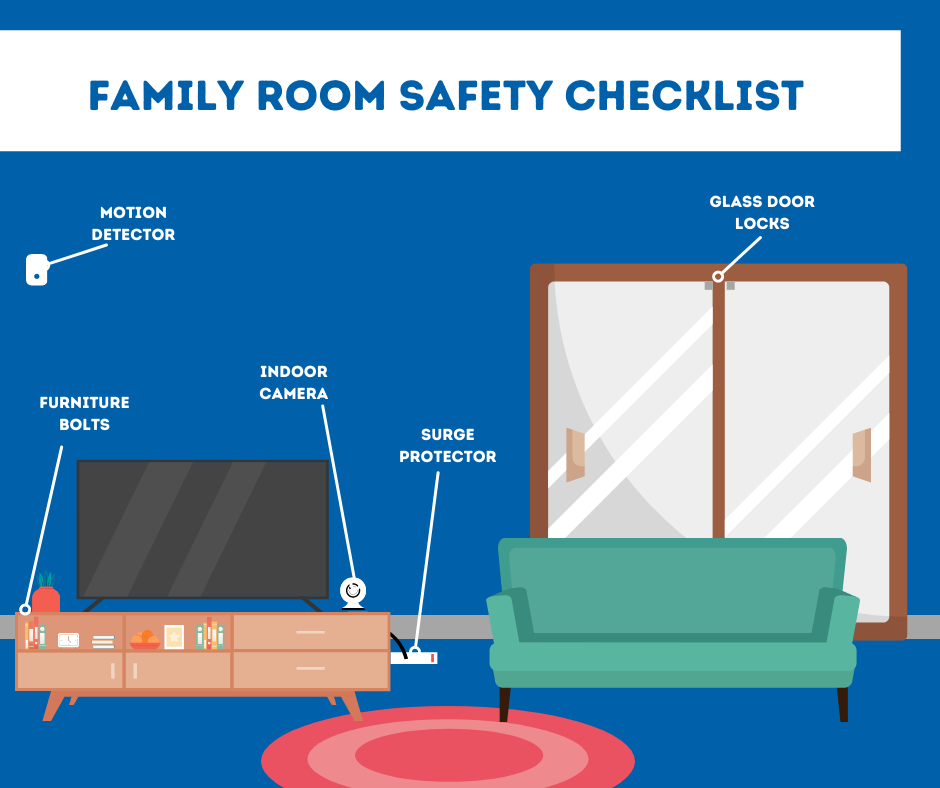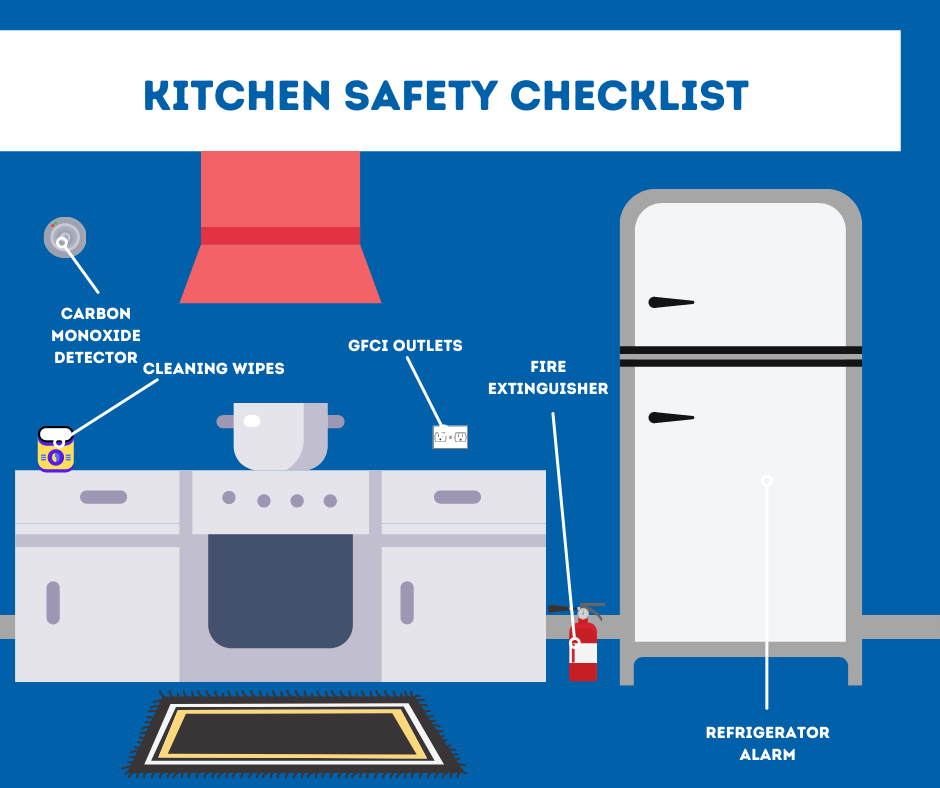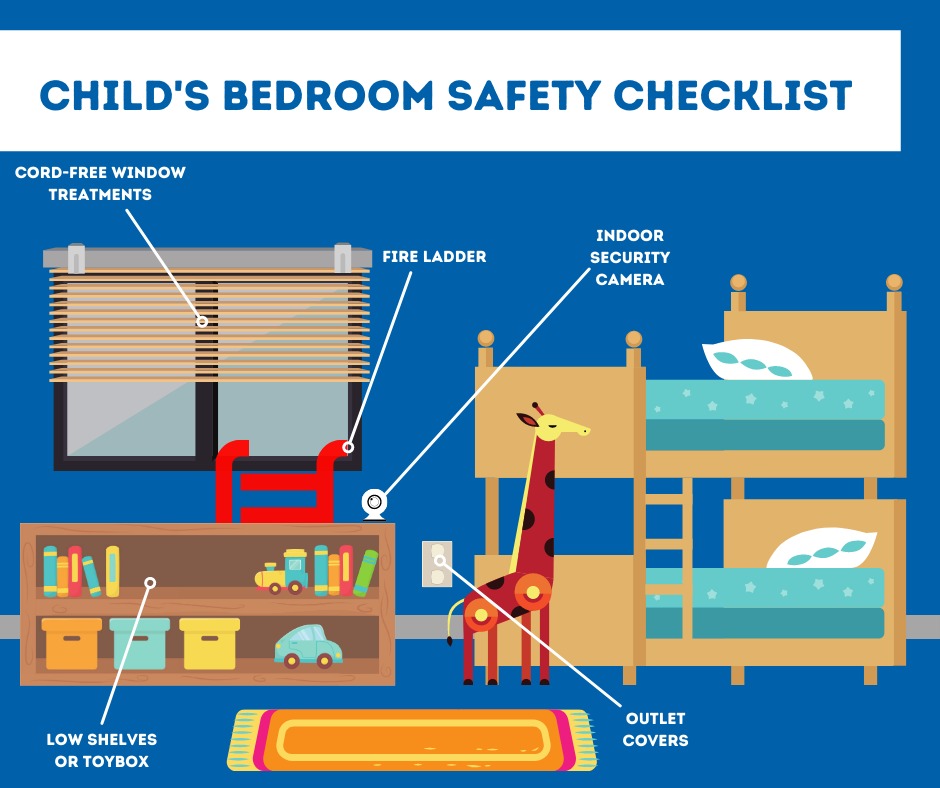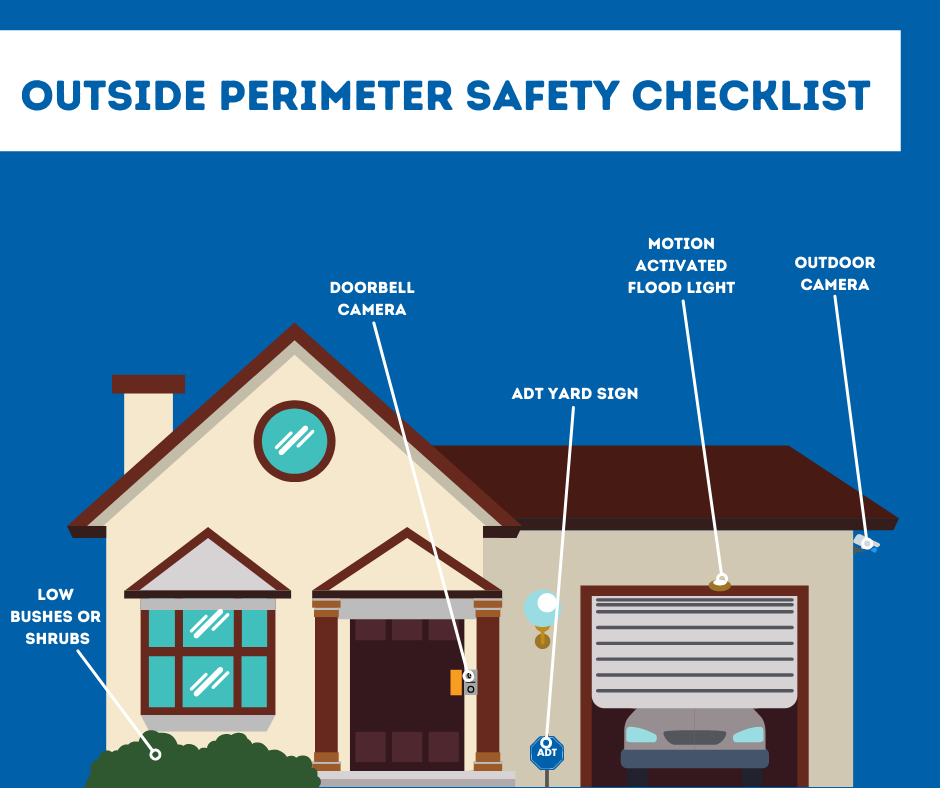Home Safety Checklist For
Being safe and secure in your home should be your largest concern. But are you forgetting one or two key safety components? Use this home safety checklist for and find out where your living space needs some work.
We give you some whole-house safety techniques, and then we whittle it down room-by-room. Then, contact (833) 205-9194 or fill out the form below to get your home safe and secure.

Essential Home Safety Checklist for
While you should take a individual room process for home safety, there are a few items that work for a lot of your rooms. These items can sync with one another through a touchscreen hub, and often can respond to one another. You might also manage all your home safety equipment with a mobile app, like ADT Control:
-
Monitored Security System: Each one of your doors and windows should use a sensor that warns you and your family to a break-in. When the alarm triggers, your monitoring team responds to the alert and immediately calls a first responder.
-
Smart Lights For Each Room: Sure, you can program your smart lights so your home is more energy-efficient. But smart lights can also allow you to keep safe during an emergency. Have your smart bulbs come on when a security alarm triggers to scare off intruders or light the way out to a safe area.
-
Smart Thermostat: Like your smart lights, a smart thermostat in should save you up to 15% in energy spending. Also, it can start an exhaust fan when your alarms senses a fire.
-
Monitored Smoke Detectors: At the very least, you should have a fire alarm on every level of your house. You can increase your fire preparedness by installing a monitored fire alarm that looks for excessive heat and smoke, and pings your round-the-clock monitoring team when it senses a fire.
-
Smart Door Locks: Every doorway that needs a deadbolt can be made safer with a smart lock. Now you can program key codes to friends and family and get texts to your mobile device when your locks are used. Your smart lock can even automatically unlock, helping you to quickly flee the house during a fire or other emergency.

Family Room Safety Checklist For
You’ll hang out most in the living room, so it may be the most reasonable place to improve your home safety. Electronics, like your TV or stereo system, probably reside in your living room, making it a popular area for burglars. Begin with installing a motion sensor or security camera in your room, then continue on with all these ideas:
-
Motion Sensors: By putting in motion detectors, you’ll have a high-decibel siren anytime they sense unusual motion in your living room. You’ll want motion sensors that ignore pet movements or you’ll have a tripped alarm every time your cat roams by for a drink of water.
-
Indoor Security Camera: An indoor security camera offers an eye on your living room. Get constant streams of everything so you can know what’s going on without leaving your bed. Or speak with your family in the room by using the two-way talk feature.
-
Surge Protector/Cord Maintenance: Safeguard all your electronics and quit overloading your outlets with a surge protector. For additional comfort, use a smart plug with surge protection included.
-
Heavy Furniture Bolted To The Wall: If you have babies or toddlers, you’ll want to attach your entertainment center or other heavy furniture to your wall. This is especially important if your family room has rugs or carpet that might make objects extra unbalanced.
-
Enhanced Locks For Glass Doors: If your family room has a sliding door that opens to a patio, deck, or porch, you already know that the latch is pretty flimsy. Use a special lock, like a metal bar or locks that are located on the bottom and top of the door frame.

Kitchen Safety Checklist For
Your kitchen has many items that should provide safety to your home. Many of these things should be a snap to add and can be purchased from the a retail store:
-
Fire Extinguisher: Fire can come from from an overfilled skillet or an errant grease splatter. Always have a fire extinguisher at hand for any stove or oven mishaps.
-
GFCI Box On Every Outlet: A circuit interrupter outlet should be installed everywhere they’re by water to ward off a deadly shock. That includes the plugs by your sink and kitchen counter. Since the late ‘80s, it’s been required to have one circuit interrupter outlet per circuit. But if you don’t want every outlet to flip off when one outlet surges, you’re going to want to use an unchained GFCI on each outlet.
-
Monitored Carbon Monoxide Detector: A carbon monoxide detector is advised for the kitchen if you employ natural gas for the oven and range. If your gas lines malfunction, the CO detector will play a loud sound and ping your monitoring expert.
-
Disinfectant Wipes Or Spray: The largest safety issue in the kitchen is the invisible bacteria and protein from blood from meat and dairy. Always store cleaning wipes or spray to sanitize your area when preparing food.
-
Refrigerator/Freezer Alarm: The food items in your fridge have to stay at a cold temperature to stay safe to consume. If you accidently leave the refrigerator door ajar, then an alarm beep will let you know so you can close the door. Some appliances already have an alarm, others don’t, and you’ll have to pick up a refrigerator alarm from the store.

Bathroom Safety Checklist For
Just because there’s not a bunch of room in your bathroom doesn’t mean that there aren’t safety hazards. From water problems to electric safety, here are a few safety ideas for your bathroom:
-
Flood Detectors: A leaking toilet or bathtub can lead to extensive destruction. Find leaks early with a flood detector and save yourself from reflooring the entire bathroom.
-
Textured Bath Mats: A slip and fall in the bathroom can be a painful occurrence, causing bumps, gashed heads, or trips to the hospital. You can prevent these issues with a non-slip bath mat for while you towel off.
-
Textured Bathtub Strips: Like a tiled floor, a tub can be a slick area to move in. Make sure each has some no-slip stickies so your feet and toes have a bumpy patch to gain traction.
-
Medicine Door Lock: If you have little children or someone with memory complications, you have to take extra precautions regarding medicine. Secure your pills and syrups by using a medicine cabinet with a locking latch.
-
Circuit Interrupter Outlet: Just like the kitchen, you will have to also install a safer GFCI outlet on each bathroom circuit. These will shut off the electricity if they ever get wet or they experience a sudden surge from a curling iron or hair dryer.

Child’s Bedroom Safety Checklist For
A child’s bedroom should pair safety with manageability. If their window shades or other items are safe but difficult to manage, then your kids may try risky activities -- like scale a chest of drawers -- to touch them. Try these straightforward, yet safe, ideas:
-
Cord-Free Window Coverings: Safety agencies have designated cords from shades and blinds a secret hazard for both children and pets. Install motorized shades that kids can easily control with a remote control. Or even better, pair your motorized treatments to your security system so they can raise without anyone’s help when the sun comes up, and lower in the evening for an easier sleep.
-
Indoor Security Camera: A security camera sitting on your child’s desk or dresser can double as a high tech baby monitor that you can see from a smartphone. And when they want something, they can use the 2-way talk button that comes with the camera.
-
Outlet Covers: While every outlet should use protective covers on them for your little children, this is doubly urgent in their bedroom. It’s the one room in your home where your toddler will most likely hang out by themselves without parental supervision.
-
Window Safety Ladder: If you use bedrooms on above the first level, then you should put in a window escape ladder. These can help a young one leave the house when the hallway or downstairs are on fire. Just remember to practice how to use them at least twice a year.
-
Toy Box Or Low Shelves: It’s weird to view a toy chest as a safety component, but you’ll get it if you’ve ever stepped on a Lego in your socked feet. A clean floor gives your child a quick way out if there’s an emergency.

Main Bedroom Safety Checklist For
Your bedroom should be a refuge, so let your safety items make life easier if you have an emergency event. After all, being wrenched awake by a wailing buzzer can be confusing.
-
Security System Touchscreen: Having a touchscreen on your nightstand gives you a sense of what’s what that noise was without jumping out of bed. You could alternatively log into your ADT mobile app but, the touchscreen may be easier to manage to use when you’re coming out of sleep and finding your bearings.
-
Device Charging Station: We use our phones for almost everything now alarm clocks, news readers, social media, and --legend has it-- even phones. The only problem is that an uncharged phone in the middle of the night cuts us off from the outside world if during an emergency. To make sure your phone always works, a an easy-to-use charging station becomes an essential.
-
Nightlights Or Voice Activated Smart Lights: A tiny light can be a beacon when you’re jolted awake from a fire alarm or other loud noises. If you have trouble falling asleep with an outlet light, install smart bulbs in your bedroom and hall. Then you can get light simply with a button push or vocal command.
-
Fireproof Safe: Store your important paperwork like insurance cards, medical information, or banking information in a fireproof safe. Your safe can be a big one that sits in your closet or a slender portable lockbox that you can grab on your way out during an emergency event.
-
Temperature Sensor: The drawback with a master bedroom is that they tend to be too stuffy or be frigid because they sit far from the thermostat. A temperature sensor can talk to your smart thermostat so you should have a nice, restful sleep at a wonderful climate.

Garage/Basement Safety Checklist For
Most safety problems in the basement or garage are with your pipes or heating system. Discovering problems early can stave away more devastating disasters in the future. So, as you take a look around your garage or basement, pay attention to these safety items:
-
Flood Sensor Or Sump Pump Alarm: Installing a flood alarm by your water heater and sump pump drain can save you from discovering a pond when you walk into your garage or basement. It’s definitely better than rummaging through a heap of destroyed storage boxes.
-
CO Detector: It’s beneficial to hang a carbon monoxide detector in a place where a gas leak can occur. If you use a gas furnace, you’ll want to put an alarm in the same area as your inbound pipes.
-
Wireless Water Shutoff Valve: If your water alarm detects a hot water heater leak or a busted pipe, then you will have to shut off the main water pipe quickly. With a remote shutoff valve, you can block water flow from your phone. That’s nice when you’re out of town and receive a flood sensor alert on your smartphone.
-
Garage Door Sensor: Leaving the garage door up brings about all types of issues. You can lose heat or air through that open door, and all sorts of animals or thieves can just walk in. A remote sensor will notify you about a forgotten garage door and allow you to close it through the app.
-
Temperature Sensor: A heat sensor in your garage or basement is a definite if you wonder about your pipes freezing. The temperature in these rooms can be wildly different than your main rooms of the house, so you may need to keep a constant look on the temperature by using your security mobile app.

Outside Perimeter Safety Checklist for
Your landscaping, drive, and front walk are just as important to defend as the interior of your home. Use this checklist to make your outside safe:
-
Doorbell Security Camera: See who’s at the front door before you answer it and welcome visitors. View packages and look at video clips if they are stolen.
-
Outdoor Security Camera: You can place outdoor cameras to guard against suspicious activity in your yard. These cameras come in handy in places where you might not have a window installed -- like around a cellar or by the garage door.
-
Window Height Shrubbery: Overgrown foliage can offer some solitude, but they also block you seeing into the yard and curb. Don’t offer potential thieves an area to hide. Plus, large bushes or greenery around your house can obstruct gutters and summon bugs.
-
ADT Signage: One of the biggest deterrents for a break-in is telling would-be rogues that you have a monitored home security system. An ADT sign by the front door and a window sticker will alert ne'er-do-wells that they might want to move on to an easier target.
-
Motion Controlled Outside Lights: Light is the greatest obstacle to those who lurk in the shadows. Motion-triggered flood lights on your porch, garage, or deck can help scare possible intruders away. Flood lights also help you get inside when you arrive back home late after work.
Contact Secure 24 Alarm Systems To Help You Finish Your Home Safety Checklist for
While Secure 24 Alarm Systems can’t help you with non-security devices on your home safety checklist, we can discuss a state-of-the-art home security. With easy-to-use devices and ADT monitoring, we can customize the perfect system for your family’s needs. Just contact (833) 205-9194 for more information or send in the form below. Or customize your own system with our Security System Designer.
